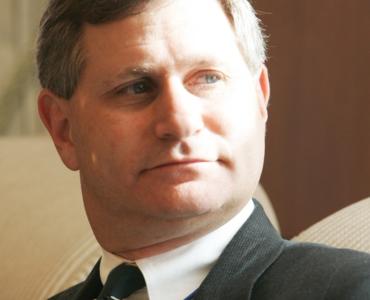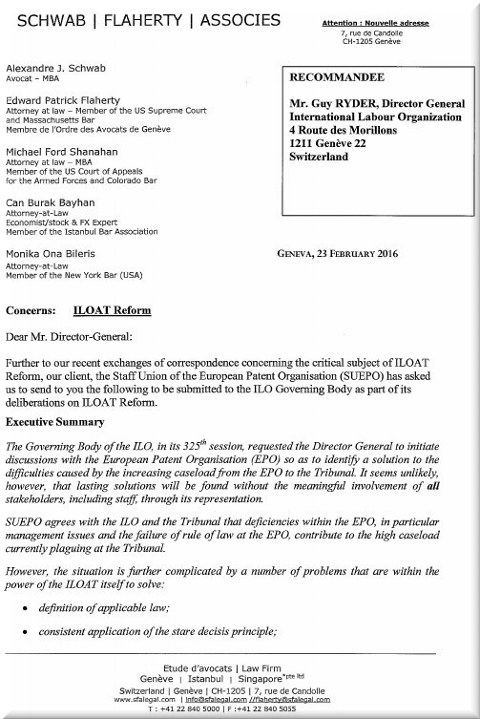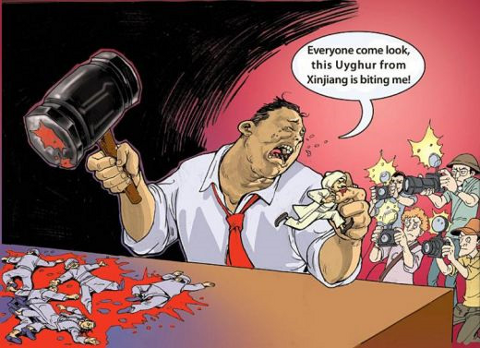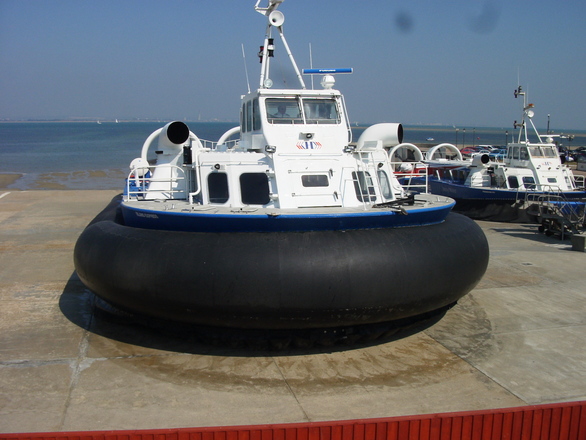Alexandre J. Schwab
Avocat – MBA
Edward Patrick Flaherty
Attorney at law – Member of the US Supreme Court
and Massachusetts Bar
Membre de l’Ordre des A vocats de Genève
Michael Ford Shanahan
Attorney at law – MBA
Member of the US Court of Appeals
for the Armed Forces and Colorado Bar
Can Burak Bayhan
Attorney-at-Law
Economist/stock & FX Expert
Member of the Istanbul Bar Association
Monika Ona Bileris
Attorney-at-Law
Member of the New York Bar (USA)
7, rue de Candolle
CH-1205 Genève
RECOMMANDEE
Mr. Guy RYDER, Director General
International Labour Organization
4 Route des Morillons
1211 Genève 22
Switzerland
Geneva , 23 February 2016
Concerns: ILOAT Reform
Dear Mr. Director-General:
Further to our recent exchanges of correspondence concerning the critical subject of ILOAT Reform, our client, the Staff Union of the European Patent Organisation (SUEPO) has asked us to send to you the following to he submitted to the ILO Governing Body as part of its deliberations on ILOAT Reform.
Executive Summary
The Governing Body of the ILO, in its 325th session, requested the Director General to initiate discussions with the European Patent Organisation (EPO) so as to identify a solution to the difficulties caused by the increasing caseload from the EPO to the Tribunal. It seems unlikely, however, that lasting solutions will be found without the meaningful involvement of all stakeholders, including staff, through its representation.
SUEPO agrees with the ILO and the Tribunal that deficiencies within the EPO, in particular management issues and the failure of rule of law at the EPO, contribute to the high caseload currently plaguing at the Tribunal.
However, the situation is further complicated by a number of problems that are within the power of the ILOAT itself to solve:
• definition of applicable law;
• consistent application of the stare decisis principle;
• granting locus standi to staff representations/unions vs avalanches of individual cases when the issue at bar is a general decision.
In respect of these issues, some suggestions are respectfully submitted. Of course, any solution to the issue of efficiency and caseload should not be at the cost of quality of justice. In fact, we take the liberty of suggesting some improvements also in the following matters:
• procedural deficiencies (discovery, equality of arms, fact finding, interim protective measures, summary dismissals);
• structural and functional deficiencies (appointment, tenure and independence of the judges; number of judges and sessions; lack of hearings).
SUEPO respectfully requests that the submissions be considered as part of the discussions and presented to the ILO Governing Body.
Introduction
In response to a surcharge of cases at its Administrative Tribunal (“ILOAT”) which has resulted in significant delays in the processing and adjudication of appeals before such Tribunal as long as four or five years, at its 325th session, the Governing Body of the International Labour Office (“GB”) requested the Director General:
(a) to initiate without delay discussions with the European Patent Organisation (EPO), in consultation with the Tribunal as required, in order to identify a solution to the difficulties caused by the number of complaints generated within the EPO and which threaten the ability of the Tribunal to serve all other member organizations, and to report to the Governing Body at its next session; and
(b) to prepare draft amendments to the Tribunal’s Statute relating to Article XII and the conditions of admission of new organizations, for consideration by the Governing Body.
While the second aspect of the decision has been addressed (in part) by way of a document containing a proposal (prepared for the Governing Body’s 326th session), to the knowledge of EPO staff members, there does not appear to be any dialogue between the EPO and the ILO or the Tribunal. Moreover, while SUEPO requested by letter the ILO Director General to directly include SUEPO and its representatives in the dialogue requested by the GB, this has not (yet) occurred. As foreseen by the Governing Body1, the discussion should include all stake holders, including the staff members through their elected staff representatives. Indeed, it would seem self-evident that the ILO, whose mission it is to defend the interests of workers, should not engage in discussions only with the employer on matters which seriously impact staff members but excludes staff representation. For this reasons, SUEPO takes the opportunity to submit a number of observations and urges you, along with the Tribunal, to consider its submissions and include them in the discussions, if any, on the matter of tackling the growing number of cases before the ILOAT from EPO.
___________
1 GB325-PFA_9-1 (Rev)_[JUR-l 51014-1]-En.
At this stage, SUEPO wishes to discuss four factors that impact on the growing number of cases from the EPO:
1. Governance issues and failure of rule of law at the EPO;
2. Stare decisis and locus standi issues;
3. Deficiencies in the structure, constitution and functioning of the Tribunal; and
4. Lack of fundamental procedural fairness measures in the Tribunal’s statute.
1. Governance issues and failure of rule of law at the EPO
As the ILO has itself acknowledged, the number of cases originating from the EPO is out of proportion with the number of EPO staff.
As the member organizations have mentioned in their responses to the GB questionnaire, one of the reasons is the broader governance issues at the EPO, and the lack of a proper social dialogue. It appears from the document submitted to the 325th Governing Body of the ILO that discussions were held with the President of the EPO. However, there has been no discussion with the staff representatives of the EPO on this matter. Considering that the Tribunal is the first and last judicial instance for almost 7000 EPO staff members, who rely on the ILOAT for the exercise of their right of access to justice, the exclusion of staff representatives from this critical discussion is highly problematic – especially because the one-sided input from the EPO administration can be, and is, misleading.
The Governing Body appears to have been informed by the EPO that its management has undertaken measures to improve its internal remedies, and to reduce litigation. This claim is blatantly false and completely unsupported. The EPO Administration takes an average of 25 months to file a position paper in an internal appeal2 (the equivalent of a “Reply” before the Tribunal), and further time to file the second round of pleadings. This is one element of an internal appellate process over which the Administration has absolute control, yet it continually refuses to carry out expeditiously. The average duration for the completion of an internal appeal is 45 months.
The Internal Appeals Committee has not had members nominated by the staff representation for some time. Any suggestion made by the Staff Committee to solve this problem was curtly brushed aside by the Administration. Previous members of the internal appeals committee appointed by the staff representation have been persecuted and/or retaliated against on account of their speaking out against abuses.
Even in individual cases, i.e., those not involving a general decision/common interests of staff members, the EPO Administration is reluctant to consider settling matters amicably, outside litigation. Recommendations of the Internal Appeals Committee in favour of staff members are rejected as a matter of routine3. The Internal Appeals Committee’s recommendations do
___________
2 CA/21/15, point 64.
3 CA/21/15, point 61.
not always appear to be consistent and in any case unverifiable due to the lack of transparency.
EPO continues to refuse to recognize SUEPO as a union (much less enter into negotiations with it). The lack of recognition and access to justice for SUEPO has been held by the Dutch Court of Appeal as a violation of Article 6 ECHR, which lifted the EPO’s immunity as a result. This has been appealed by the EPO to the Dutch Supreme Court, where it is currently awaiting adjudication. The respect for the rule of law is so minimal that a Vice-President of the EPO went on Dutch national television on 28 January 2016 and stated that, while the EPO itself appealed to the Supreme Court, it will not accept a Supreme Court’s decision on this matter if it were not to confirm EPO’s immunity!
It has not been enough for EPO to refuse recognition for SUEPO. It began seriously targeting elected staff representatives (from SUEPO) during the past two years and has, recently, summarily dismissed two staff representatives in Munich and downgraded a third, all on the basis of spurious charges directly related to their staff representation duties. Several staff representatives from SUEPO based in the Hague are being targeted at this moment. This was disingenuously explained by an EPO Vice-President in the interview cited above as being a “pure coincidence”.
Under these circumstances, the ILO Governing Body cannot obtain reliable statements from the EPO Administration about the workings of the EPO internal appellate system or the emerging caseload4. It is essential that the ILO seek and receive a balanced analysis if measures are to be found to enable the Tribunal to administer justice effectively also for the almost 7000 staff members of the EPO. For this, the input of staff representatives appears to be essential. Moreover, involvement of staff representatives would be consistent with the ILO and its Tribunal’s historic mission5, and would avoid giving the impression that the Tribunal might dispose of the caseload simply by limiting itself to formalistic points and thereby risking rubberstamping decisions of rogue administrations.
___________
4 The draft proposal to the 326th Governing Body provides for the standards to be fulfilled by organizations applying for a membership at the Tribunal, vis-à-vis their internal justice systems. It also proposes the withdrawal of an organization’s membership (by way of the Governing Body withdrawing its approval) in case it no longer met these standards or if the inefficiency of its internal means of appeal hinders in a lasting manner the proper functioning of the Tribunal.
5 It is important to recall that the ILOAT is the successor to the League of Nations Administrative Tribunal (LNT), the latter of which was taken over by the International Labour Conference, acting at the request of the League of Nations Assembly in 1946 and reconstituted as the ILOAT with some modifications to its Statutes.
The LNT arose from a report of the Rapporteur of the Supervisory Commission of the League of Nations in 1925, which proposed that it be a judicial tribunal which would ensure to officials the firm conviction of safety and security emanating from justice, provide a judge for every dispute, and preclude the possibility of one of the parties being a judge in his own cause. The Rapporteur also found that such an administrative tribunal would increase rather than reduce the authority and position of the administration, that justice was above all men, and that all men were subject to justice, no matter what their function or position. After its creation, the 10th League of Nations Assembly in 1929 noted with approval that the existence of the LNT was one of the safeguards enjoyed by the League staff for the proper application of their terms of appointment and the regulations to which they were subject.
2. Stare decisis and locus standi issues in the Tribunal’s jurisprudence
(a) Stare decisis and Applicable law
The ILOAT Statute and Rules impose no obligation that the Tribunal follow its prior announced jurisprudence in cases similar in fact and/or law, often resulting in a divergence of outcomes for similar cases. This undermines the confidence of both litigants and counsel in any judicial system, as well as predictability. It also may secondarily contribute to the increase in cases before the Tribunal as some complainants may still insist on bringing their claims to the ILOAT even though prior similar cases have not succeeded in the hope that the ILOAT will not follow its prior jurisprudence in a similar case.
The Tribunal’s Statute does not have a specific provision on the applicable law (unlike, for instance, that of the Statute of the International Monetary Fund Administrative Tribunal). Although the Tribunal primarily bases itself on the internal law of an organization, it also claims to apply certain “general principles of law” as well as “general principles of international civil service law.” However, the Tribunal has neither defined those general principles nor recognised the applicability of international conventions and covenants — including the ILO’s own conventions, and the conventions recognised by all EPO Member States —on the ground that an Organization is not party to such convention and covenants. This includes conventions (like the ECHR, and in some cases ILO conventions) having risen to the status of binding, customary international human rights law.
Vague references to general principles is not sufficient. There is a need for a proper explanation of which principles are applicable, and how they are to be interpreted and implemented. To increase the clarity of the law and confidence in the justice administered by the Tribunal, the interpretation and judgments of competent bodies should be referenced as authoritative, if not binding. For instance, the jurisprudence of the European Court of Human Rights should be taken into account if one of the rights subject to the European Human Rights Conventions is at issue.
Suggested solution: An express amendment to the Tribunal’s statute listing the applicable law and its sources, including binding human rights law, would lessen the confusion surrounding this issue.
(b) Locus Standi issues
The Statute of the Tribunal does not give staff committee/associations and unions standing to bring complaints on behalf of the staff members they represent. Each individual affected must bring his or her own complaint – thereby resulting in a substantial increase in the number of individual cases that are brought to the Tribunal, and therefore the workload of the Tribunal.
This was overcome in the past by the Tribunal allowing complaints filed by members of a staff committee, in such capacity, in respect of matters concerning the common rights and interests of the staff members they represent (as it did in Judgment Nos. 1149, 1618, 2562, 2762, 2875, 2876, 2919.). However, the Tribunal’s jurisprudence has shifted in the past few years (explained farther below), leading to an increase in the number of individual complaints filed (see Judgments 2953, 3427, 3515).
A further issue concerns so-called “general decisions”. They cannot be challenged as such if they require individual implementation; in that case, an employee must wait until the general decision is applied to his/her detriment before being able to challenge the legality of the general decision itself. However, in theory, general decisions can be challenged directly if an
individual decision is not required. In the past, the Tribunal has taken a pragmatic stance and admitted challenges to general decisions whose introduction changed ipso facto the legal position of employees (see for instance Judgments 1451, 1618, 1660, 2244, 2279, 2300). Recently, however, the Tribunal has departed from its earlier jurisprudence and has taken a more restrictive approach: see Judgments 3291, 3427, 3454, 3461, 3466. The result is, inevitably, a surge of complaints against specific, individual decisions made in application of a general provision that can no longer he challenged as such by a few staff representatives.
To illustrate, in the years 2014 and 2015, four (4) major decisions were issued by the EPO’s Administrative Council amending a substantial part of the Service Regulations, allegedly in breach of the staff members’ acquired rights. Since these decisions affected most, if not all, EPO staff members – either immediately or with a certainty of impact in the future – representative complaints from SUEPO (on behalf of the staff members it represents) and/or complaints from the Staff Committee would have been the simplest and most efficient way to litigate these matters6. Since this is not possible, EPO staff members have been forced to appeal every single decision having an adverse impact, even if those decisions were based on one single AC decision. For instance, the career progression decision (CA/D 10/14) introduced several changes with respect to step advancement and transposition to a new grade. Each of the staff members affected had to appeal each of these impacts, all arising from CA/D 10/14. This not only increased the number of complainants, but also the number of complaints filed by each complainant.
Suggested solution: Permitting staff committees and registered trade unions/associations to bring cases on behalf and in respect of the staff members’ common interests and rights [as the Tribunal did in the past - in Judgment Nos. 1618, 2919]. To have a real impact, this has to be introduced by way of an amendment to Article II of the Tribunal’s statute.
Any solution to the issue of efficiency and caseload should not be at the cost of quality of justice. In fact, we take the liberty of suggesting some improvements also in this respect:
3. Procedural Deficiencies
(i) Discovery:
The current ILOAT Statute and Rules have no formal mechanism for discovery by a complainant of critical documentation or information in the hands of the defendant organisation, substantially hampering a complainant’s ability to meet his/her burden of proof in their appeal (or severely impairing their right of defence when accused of misconduct).
Suggested solution: It is suggested that Article 7 of the Tribunal’s statute be amended to include specific provisions relating to discovery, default and confidentiality.7
___________
6 It must be noted the Hague Court of Appeal considered the impossibility for a Union like SUEPO to file a complaint before the ILOAT to be a “manifest deficiency” in the protection of the rights guaranteed under the ECHR, warranting the lifting of immunity granted to the EPO (VEOB et al. v. EPO, Appeal Court of the Hague, Case No. 200.141.812/01, Decision dated 17 February 2015).
7 SUEPO suggests that the following provisions be considered as part of the said amendment:
DISCLOSURE
(ii) Lack of provisional or interim measures:
There are no procedures for obtaining emergency judicial intervention, e.g., for suspending the execution of an unlawful act or to order the Defendant to take specific measures to protect the rights or interests of a staff member in cases where the decision is evidently unjust and/or has a serious, possibly irreversible, impact on the staff member concerned. The importance of interim measures is highlighted by the fact that the Tribunal on occasion does not order the reintegration of a staff member who has been dismissed, because of the time elapsed.
Suggested solution: Article 15 of the Tribunal’s Rules can be amended to include these in the category of provisional orders (but not merely in between sessions or by the President alone).
(iii) Inequality of arms:
Many of the deficiencies of the current system result from a gross inequality of arms between complainants and defendant organisations. Equality of arms is a norm that arises out of natural justice, and is a jurisprudential principle of international as well as regional human rights tribunals. This principle is a part of the right to fair trial, regulated by Art. 6 of the ECHR, and Article 14(1) of the ICCPR (as interpreted by the Human Rights Committee). Equality of arms involves giving each party the reasonable possibility to present its cause, in conditions that will not put a party at a disadvantage against its opponent. Therefore, the principle of equality of arms forbids all inequalities in a trial and requires, inter alia, disclosure by a party of relevant documents or evidence to the other party and access to legal services. The complainants before the ILOAT — staff members — are individuals who normally have no experience with the prevailing procedures, have no legal background and must pay for legal support from their own means. In contrast, the Organisation has a number of internal and external lawyers at its disposal. Moreover, the decision-taker has access to almost infinite funds and takes no personal risk assigning those funds to a given case. Unfortunately, these inequalities are evidenced throughout the current ILOAT proceedings, for example: there are no formal discovery procedures or obligations, there are no provisions for examining witnesses, there are no means to compel Defendant to produce evidence (nor in
___________
- When a complaint is lodged with the ILOAT, the defendant organization shall produce all documents or information (which shall include without limitation any and all informal documents such as e-mail messages, correspondence retained in electronic form only, handwritten notes, and oral recordings) at the request of the claimant or may object to such request, subject to the following paragraph of this Article.
- Where a claimant’s request for disclosure of documents or information has been ignored or resisted by the defendant organization, the claimant seeking disclosure may file an application with the ILOAT to compel disclosure. The parties thereto shall demonstrate before the Tribunal the reasons for the requested documents or information to be disclosed or not disclosed, after which the Tribunal shall expeditiously render its decision on such request.
- Any objections to a claimant’s request for disclosure of documents or information must be based on a legally recognized privilege or right, and shall not be denied upon the perfunctory claim of “confidentiality”.
- Where the defendant organization withholds the requested documents or information in contravention of an order from the ILOAT ordering its disclosure to the claimant, the defendant organization shall have judgment entered against it, and the claimant shall be awarded its full requested redress.
- The burden of proof shall be upon the defendant organization requested to produce documents or information to show that it has fully complied with any and all discovery requests.
fact any rules of evidence), and the orders of costs do not normally cover the full measure of legal fees which the complainants incurred in bringing their appeal.
(iv) Lack of investigation or inquiry by the Tribunal:
There is an absence or near absence of inquiries, beyond the exchange of filings, between the Tribunal and the parties. The Tribunal’s reliance on the fact-finding by internal appeals bodies, which are not judicial instances, places a heavy burden of proof on the staff member/complainants.
Suggested solution: The Tribunal must be able to take investigative measures without waiting for the examination of cases in a judgment session. A case should be assigned, from the introduction of a complaint, to a judge who would take timely and useful measures of inquiry, and for which purpose the parties could submit applications.
(v) Summary dismissal of complaints
Use of the Article 7 Summary Procedure appears to have been employed by the Tribunal to a great extent over the past two years as a means to reduce the current case backlog8.
Over-reliance on this procedure should be firmly discouraged. If a summary dismissal of complainant’s claims were unwarranted, it would amount to a violation of a fundamental aspect of natural justice, and could well lead to the unintended consequence that a national court might assert jurisdiction in spite of the immunity of the Organisation.
Suggested solution: Limit the application of the Article 7 procedure to the most extreme cases (as was the practice of the Tribunal prior to 2014).
4. Structural and functional deficiencies
(i) Independence and Impartiality of the Tribunal:
(a) Appointment of Judges
There is no transparency in the process of appointing the Tribunal’s judges. The involvement of the ILOAT DG (in the first instance), upon whose recommendation the Governing Body appoints the Judges is apparently a “long standing practice” – which seems to have no basis in the Tribunal’s Statute. There is an apparent lack of guarantees ensuring independence from the ILO executive. Furthermore, the ILOAT Statute lacks meaningful requirements for the minimum professional qualifications of its judges. The current appointment and reappointment (see below) procedures undermine the credibility of the judges and hence of the Tribunal.
___________
8 Prior to July 2014, the summary procedure was used approximately 18 times since the ILOAT’s formation in 1945, the last time in 1997; since July 2014, it has been used in some fifty-eight (58) cases. While SUEPO strongly advocates the efficient and expeditious treatment of all pending appeals, it abhors the apparent sole reliance by the Tribunal on the Article 7 procedure to address the backlog which on it faces seems to be a bold face denial of justice to those complainants whose complaints were summarily dismissed under Article 7.
Suggested solution - The initial appointment of the judges and Registrar should be by mutual agreement between the ILO and Staff Association/Union representatives of the defendant organisations. It would be beneficial to the preservation of independence with regard to appointment if the minimum qualifications for Tribunal judges were incorporated in the ILOAT Statute.
(b) Tenure and Reappointment:
The Tribunal statute has this basic defect: Article III (2) provides that the seven judges “shall be appointed for a period of three years by the Conference of the ILO”, and there is no prohibition on re-appointment for further three-year terms. In effect, the Tribunals’ judges are “contract judges” whose appointments are dependent on the repeated authorization of the very body (ILO) which is often a defendant organisation in litigation before them. Furthermore, the honoraria of the judges are paid by the defendant organisations against which they may be obliged to enter adverse judgments. This state of affairs is clearly incongruent with the well-settled rule that judges be independent and beyond any reproach in the form of real or perceived conflicts of interest. “Contract judges” violate the UN’s own standard of independence of the judiciary.
Dr. CF Amerasinghe in his seminal textbook, “Principles of the Institutional Law of International Organisations” (Cambridge University Press, 1996), at page 455 opines on the reappointment process:
“Judges could be influenced to give biased decisions in favour of the organisation concerned in the hope of being re-appointed, particularly considering that their terms are rather short. Hence, the possibility of re-appointment may not be entirely conducive to independence and impartiality. For this reason, a limitation on the power to re-appoint to one additional term may work to some extent in favour of independence and impartiality, at least during the second term.”
Suggested solution - As the UNDT/UNAT recently adopted, ILOAT judges should be appointed to a single, non-renewable seven (7) year term.
(c) Conflict of Interest
The ILOAT Statute contains no provision prohibiting participation or requiring disclosure in cases where a judge has had previous experience or dealings with a party or issue before the Tribunal. Nor is there a procedure available to parties to prevent a judge from presiding over a case where there exists a conflict of interest or the appearance of same. Moreover, a complainant does not know which judges will sit on his/her case until the judgment is rendered, and therefore, it would be impossible for a complainant to raise a conflict of interest concern because a final and binding judgment has been entered.
Suggested solution - Parties should be notified of the judges handling their case prior to the panel’s consideration of the same, and be given sufficient time to assert a claim of conflict of interest. An independent procedure for addressing such claims of real or apparent conflict of interest must be created and implemented. Likewise, it must be mandatory for judges to disclose a real or apparent conflict of interest with a party or a matter before him/her.
(d) Financial Independence
There is very little transparency with regard to how the Tribunal is funded and how the judges are awarded. Cases are financed by the defendant organisations on a per case basis. This means that the Tribunal and the judges are financed by the international organization at bar. These concerns are increased when one considers the disproportionately low success rates of complainants before the Tribunal.9
(e) Improper Influence
Not only does the ILOAT Statute not contain any provisions guarding against improper influence, no public documents set out the practices of the Tribunal with regard to this issue. To SUEPO’s knowledge, the Tribunal (the Registrar) has refused to invite staff representatives for any discussion on its progress (except for one meeting in 2014). However, some authorities in the Tribunal have, in the past (documented, for instance, in 2009) attended the yearly meeting of legal advisors from subscribing member organizations. While it is neither alleged nor asserted that so far there has been improper influence of the Tribunal, it is our contention that an amendment to the ILOAT Statute to include safeguards against outside pressures would likely inspire confidence that such occurrences are in fact accounted for by the Tribunal, and are expressly prevented.
Suggested solution: All aspects of the financing, funding and compensation of the Tribunal and the judges should be completely transparent and made public, in detail; ex parte meetings between the ILOAT judges and representative of defendant-organisations should be discouraged, and when unavoidable, promptly disclosed. When such meetings occur, staff/union representatives should be invited to attend.
(ii) Insufficient number of judges and judgment sessions
This is an apparent problem considering the increasing caseload of the Tribunal. The Tribunal’s composition has not been adjusted for decades, nor has there been an increase in the number of regular judgment sessions, notwithstanding the disproportionate increase in its caseload10. There is no rationale behind not increasing either of these, considering that the caseload has increased manifold. A few extra sessions in the last years were ad-hoc and have not resulted in a systematic increase in the Tribunal’s capacity.
Suggested Solution: Consider increasing permanent membership to 9 or 11 and increasing permanent sessions to four [4] per year; or creating a two tier system similar to the UN Dispute Tribunal, with a full-time, sitting first instance Tribunal, and a second tier, appellate instance that meets as many times a year as necessary to expeditiously address all pending cases without the creation of a backlog.
(iii) Lack of Hearings since 1989
The ILOAT has not held oral argument or heard witnesses in any case (despite repeated requests for witness examination and oral argument in numerous cases) since 1989, even
___________
9 In the years 2000-2014, complainants from all subscribing organisations won some measure of compensation, no matter how small, in 30% of the cases or less – but this figure includes cases where the complainant was compensated only for delays in the procure. In other years, this figure was 15% or less. The percentage of EPO cases where the complainant actually prevails on the substance is estimated to be at less than 5%.
10 One extraordinary judgment session was held in 2015 apparently to attempt to deal with the case backlog.
though its Statutes expressly contemplate hearings as the norm rather than an exception11. Article 10 of the Universal Declaration of Human Rights provides:
“Everyone is entitled in full equality to a fair and public hearing by an independent and impartial tribunal, in the determination of his rights and obligations and of any criminal charge against him.”12
Article 6(1) of the ECHR similarly provides for “a fair and public hearing within a reasonable time by an independent and impartial tribunal established by law.” In Stefanelli v San Marino13, the European Court of Human Rights held:
“…it is a fundamental principle enshrined in Article 6(1) that court hearings should be held in public. This public character protects litigants against the administration of justice without public scrutiny; it is also one of the means whereby people’s confidence in the courts can be maintained.”
The Redesign Panel on the United Nations System of Administration of Justice stated, in listing the international standards on the right of access to justice, as follows: “Hearings, too, are a clear requirement in international standards whenever there are disputed issues of fact.” In view of the foregoing, absent some well-articulated, reasoned exception particular to the case at bar, all complainants seeking oral argument and examination of critical witnesses before the Tribunal should be accommodated, irrespective of the challenge to resources that such a change in practice will likely cause; the Tribunal’s resources should be increased to meet its fundamental obligations articulated by the UDHR and ECHR, and as set out in its own statute, rather than as is the current practice, which results in the denial of the complainants’ rights fundamental right to a public hearing.
Conclusion:
SUEPO agrees with the ILO and the Tribunal that deficiencies within the EPO (both with respect to its governance as well as its internal justice system) contribute to the high caseload currently plaguing the Tribunal. A lack of social dialogue further aggravates this situation. It seems unlikely that lasting solutions will be found without involvement of all stakeholders. SUEPO therefore maintains its request for involvement of the Staff Unions and/or staff representations of the member Organizations in the ongoing discussions on the Tribunal’s management. SUEPO requests that the submissions in the present document be considered as part of these discussions and presented to the Governing Body. As pointed out in this
___________
11 ILOAT Statute Article V provides: “The Tribunal shall decide in each case whether the oral proceedings before it or any pa rt of them shall be public or in camera.”
12 This right is also contained in Article 14 of the International Covenant on Civil and Political Rights (“ICCPR”), Article 25 of the American Convention on Human Rights, African Charter on Human and Peoples’ Rights.
13 [2000] European Court of Human Rights Application No. 35396/97.
document, this is an opportunity to improve the efficiency of the Tribunal and enhance its credibility and stature.
We look forward to hearing from you soon; thank you again for your courtesy and attention in this regard.
Respectfully,
Schwab, Flaherty & Associés
Edward Patrick Flaherty
External Counsel to SUEPO
CC: Client
President, EPO (by email only)
President, EPO AC (by email only)
ILOAT Registrar (by email only)
FICSA (by email only)
ILO Staff Union (by email only)
























 Content is available under CC-BY-SA
Content is available under CC-BY-SA